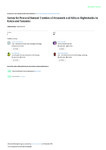Survey for Pest and Natural Enemies of Amaranth and African Nightshades in Kenya and Tanzania

View/
Date
2015Author
Mureithi, Daniel Mwangi
Mworia, Jackline Kendi
Meyhoefer, Rainer
Murungi, Lucy Kananu
Losenge, Turoop
Akutse, Komivi Senyo
Ekesi, Sunday
Fiaboe, Komi K. M.
Metadata
Show full item recordAbstract
In the context of the HORTINLEA project (www.hortinlea.org) baseline survey activities were conducted to identify the diversity, distribution, incidence, and damage of arthropod pests and natural enemies infesting leafy indigenous vegetables, i.e. amaranth and African nightshades in 289 farms (15 counties) in Kenya and 209 farms (16 districts) in Tanzania for two rainy seasons of the year 2014. The survey findings were important in identification of the key pests that to be addressed and the potential natural enemies that could be used for their management. Visual examination of theplants,shaking andbeating,sweeping as well as destructive samplings were carried out.For leafy amaranth, lepidopteran defoliators (Spoladea recurvalis, Spodoptera sp.), stem weevils (Hypolixus sp.), aphids (Aphis gossypii, Myzus persicae) and stink bugs (Coreidae and Pentatomidae) were the major pests, accounting for 1.9%, 12.6%, 25.1%, and 4.6% respectively of all the pests collected for instance in Kenya. In both countries, aphids (Aphis sp., Myzus persicae), flea beetles (Phyllotreta sp., Epitrix sp.), and spidermites (Tetranychus sp.) were the major pests on African nightshades accounting for 15.0%, 5.7% and 58.8% respectively for the Kenya survey. Natural enemies were frequently recorded in both seasons. Most important predacious species were ladybird beetles, Orius bugs and Phytoseiulus spp., while parasitoid species belonged mainly to the Braconidae family. Generally higher pest pressure and natural enemy (8666 individuals) abundance was obtained in the long rain season as compared to the short rain season (2356 individuals) in Kenya from the two crops. However, lepidopteran defoliators were more abundant in the short rainy season (143) than in the long one (75) in Kenya. Moreover, in Tanzania, more stem weevils (135) were recorded in short rain season compared to the long rains season (22). Higher abundance of flea beetles (166) was observed in the high altitude region of Tanzania as compare to the low altitude (23). This study reveals that aphids, beetles, lepidopteran defoliators, and spider mites are key pests in production of leafy amaranth and African nightshades. The population dynamics, infection pathways, and profiling of viruses transmitted by aphids on African nightshades are being studied.
